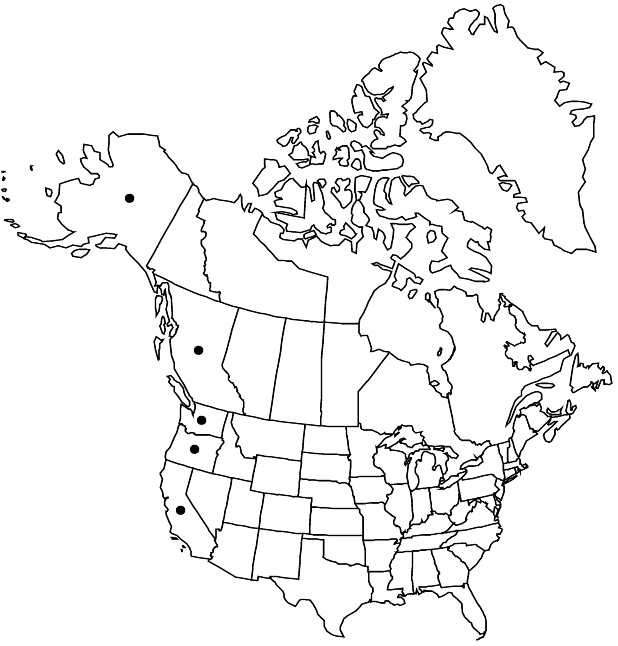Ribes bracteosum
in W. J. Hooker, Fl. Bor.-Amer. 1: 233. 1832 ,.
Plants 1–4 m. Stems erect, with dense, yellowish, shiny, sessile, crystalline, round glands, sparsely pubescent throughout; spines at nodes absent; prickles on internodes absent. Leaves: petiole 2–10 cm, sparsely pubescent; blade ovate, deeply 5–7-lobed, cleft 1/2+ to midrib, (1.5–)2–10(–22) cm, base cordate, surfaces with yellow, dull, sessile glands and sparse hairs abaxially, with yellow, shiny, sessile glands and glabrous adaxially, lobes with main segments ovate-lanceolate, margins 1–2 times sharply serrate, apex acute, shallowly lobed. Inflorescences ascending to erect, 20–50-flowered racemes, (10–)15–30 cm, axis sparsely pubescent, flowers evenly spaced. Pedicels jointed, 5–12 mm, pubescent and glandular; bracts conspicuous, proximal ones ovate, lobed, distal ones narrowly oblong, unlobed, (3–)4–5 mm, sparsely glandular and pubescent. Flowers: hypanthium green, saucer-shaped, widely flared, 0.5–1.5 mm, ± pubescent and sparsely glandular abaxially, glabrous adaxially; sepals nearly to somewhat overlapping, spreading, brownish purple to greenish or sometimes nearly white, ovate-lanceolate to oblong-lanceolate, 3–5 mm; petals widely separated, erect, white, cuneate-flabelliform, not conspicuously revolute or inrolled, 1 mm; nectary disc wine red, thick, lobed, covering and submerging ovary; stamens slightly longer than petals; filaments linear to slightly broader at base, 1 mm, glabrous; anthers white, transversely oblong-cordate, 0.5 mm, broader than long, apex shallowly notched; ovary somewhat hairy and densely sessile-glandular; styles connate 1/4–1/2 their lengths, 1 mm, glabrous or hairy. Berries bland, black, subglobose, 8–10 mm, glandular. 2n = 16.
Phenology: Flowering Feb–Jun.
Habitat: Stream banks, moist woods, floodplains, shorelines, thickets, avalanche tracks
Elevation: 0-1700 m
Distribution

B.C., Alaska, Calif., Oreg., Wash.
Discussion
Ribes bracteosum occurs along the Pacific Coast from southeastern Alaska to northern California. Its thin leaves have a sweetish, disagreeable odor and the conspicuous bracts bear acicular, mostly persistent processes near the base along the slightly winged, stipular margins.
Selected References
None.